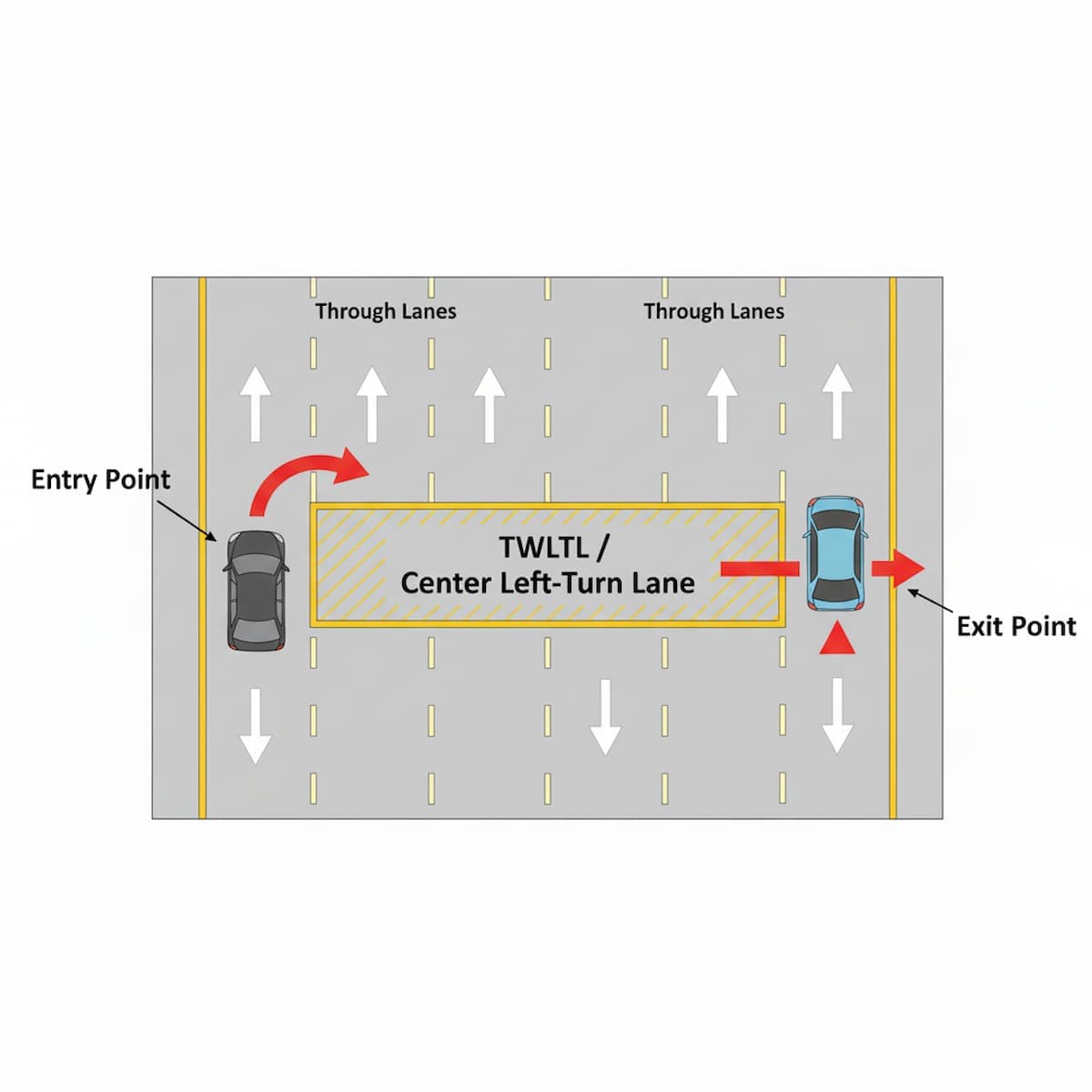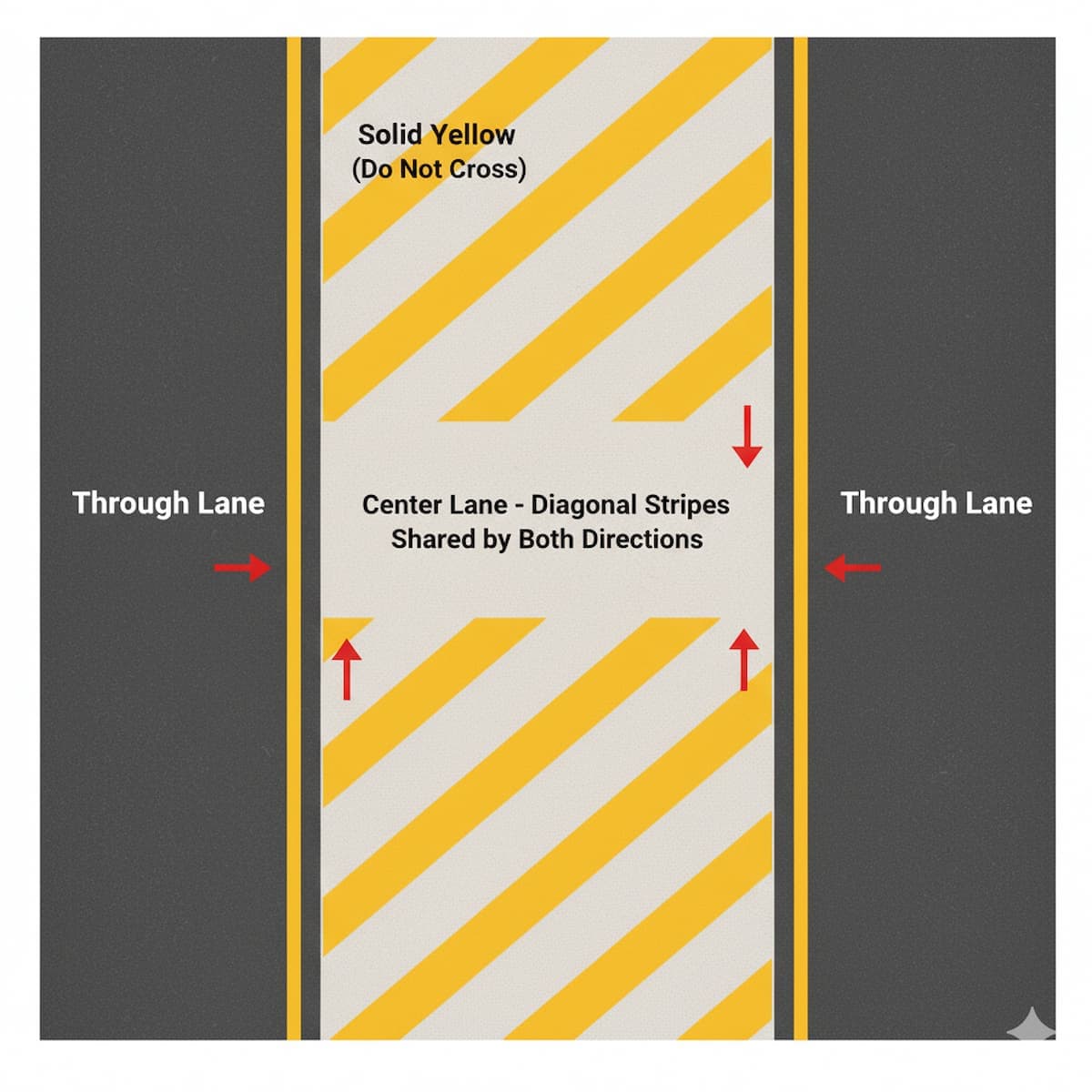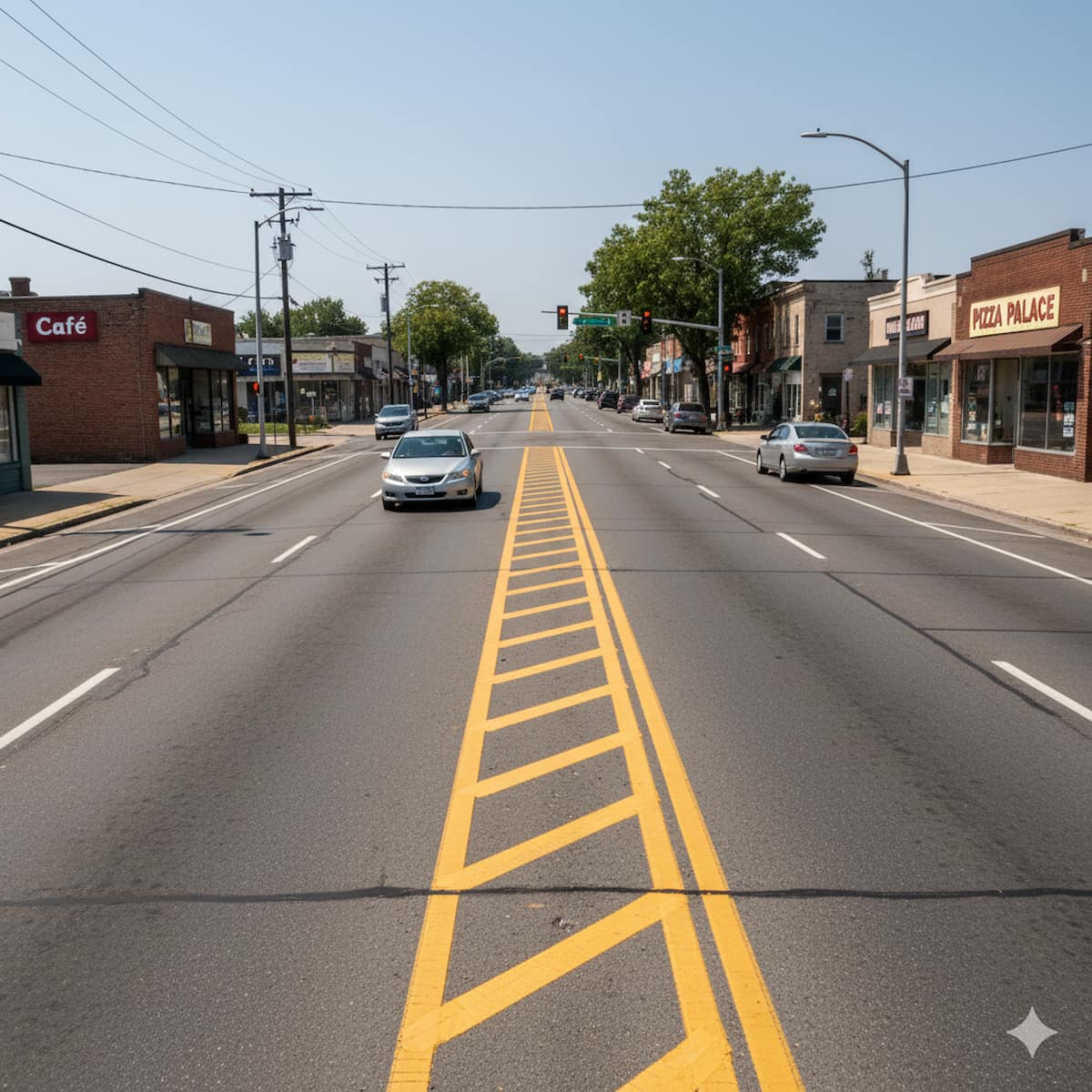
How to use a two-way left-turn lane (TWLTL): quick overview
A two-way left-turn lane (also called a center left-turn lane or TWLTL) is a special center lane marked by alternating yellow stripes—solid on the outside, broken or striped on the inside. Drivers traveling in either direction may use this lane exclusively for making left turns into driveways, side streets, or businesses, or for entering the roadway from a side street or driveway. The TWLTL may never be used for passing, through travel, or extended queuing.
Where to enter the center lane for a left turn
Look for the solid-and-striped TWLTL pattern: a solid yellow line separates the through lane from the center lane, while broken or alternating diagonal stripes run down the middle of the center lane itself. You may enter the TWLTL only where the inside line transitions from solid to striped. Entering where both lines are solid violates the marking and creates head-on conflict risk.
Do not use TWLTL for passing or queuing
The center left-turn lane is not a passing lane, acceleration lane, or parking zone. Using it to bypass slower vehicles is illegal in all states and extremely dangerous because opposing traffic may enter from the other direction at any time. Similarly, do not queue in the TWLTL waiting for a parking space or drive-through lane—complete your turn promptly or wait in the through lane if no gap exists.
Staging safely without blocking through lanes
When preparing a left turn, signal early (at least 100 feet in advance), check your mirrors and blind spot, then movecompletely into the center lane so your vehicle does not block through traffic. Yield to oncoming vehicles and to any driver already in the TWLTL from the opposite direction. Once a safe gap appears, complete your turn in one smooth motion. Do not linger or creep forward into the opposing lane.
Enforcement notes for improper TWLTL use
Officers commonly cite violations such as improper lane use, illegal passing, or failure to obey traffic control devices when drivers misuse the center lane. Fines vary by state but typically range from $100–$300, plus points on your driving record. In some jurisdictions, using the TWLTL to pass can trigger a reckless driving charge if it causes a near-collision.

Reading TWLTL patterns: solid-striped-solid sequences
Understanding the marking sequence is essential for safe and legal TWLTL use. The outer edges of the center lane are solid yellow, signaling that adjacent through-traffic lanes must not cross except to enter the TWLTL for a turn. The interior of the center lane features alternating diagonal yellow stripesor a broken yellow line, indicating that this space is shared by opposing directions. This unique pattern instantly identifies a two-way left-turn lane and distinguishes it from a standard passing zone or painted median barrier.
Entering and exiting the TWLTL: legal transition points
You must enter the center lane where the pavement markings permit—typically where the inside line changes from solid to broken or striped. Many TWLTLs begin with a tapered entry zone; if both yellow lines remain solid, you have not yet reached a legal entry point. Similarly, when exiting the roadway via a left turn, position yourself in the TWLTL early enough to signal and yield, but do not drive down the center lane for excessive distances. Most states limit center-lane travel to 200–300 feet before completing the turn.
Turning left from a driveway into the TWLTL to merge right
One of the TWLTL's key benefits is allowing drivers exiting a side street or driveway to turn left into the center lane, accelerate to match traffic speed, then merge safely into the through lane when a gap appears. This two-step maneuver reduces conflict and improves traffic flow on busy commercial corridors. After entering the TWLTL from your driveway, check over your right shoulder, signal right, and merge as soon as practical—do not treat the center lane as a through lane.
Common TWLTL violations and how to avoid them
Even experienced drivers sometimes misuse the center left-turn lane, often without realizing the risk or illegality. Below are the most frequent mistakes and practical tips to stay compliant and safe.
Illegal passing from TWLTL
Using the TWLTL to pass a vehicle that is traveling slower than you want is always illegal. The center lane is shared by opposing traffic, so you can encounter a head-on collision at any moment. Officers aggressively enforce this rule, and the violation can result in significant fines, points, and even reckless driving charges if it creates a dangerous situation. If you need to pass, wait for a legal passing zone marked by a broken yellow centerline.
Waiting in the center lane for too long
While you may briefly stage in the TWLTL to wait for oncoming traffic to clear, extended queuingblocks the lane for others and increases rear-end collision risk. If no gap appears after 10–15 Seconds, consider repositioning in the through lane or seeking an alternate route. Do not treat the TWLTL as a parking or waiting zone.
Entering at the wrong location: solid vs striped boundaries
A common mistake is entering the TWLTL where the inside boundary line is still solid. This often happens at the beginning or end of a center lane section, where the markings taper. Wait until you see broken or diagonal stripeson the inside before moving into the center lane. Crossing a solid line to enter the TWLTL is a marking violation and can draw a citation.
Head-on collision risk when both directions use the lane simultaneously
Because the TWLTL is shared, two drivers preparing left turns from opposite directions can occupy the center lane at the same time. Always yield to opposing traffic already in the lane and watch for vehicles entering from driveways mid-block. Approach the center lane at a controlled speed and be ready to stop if you see headlights or taillights ahead in your path.
Nighttime and adverse weather: visibility challenges in the TWLTL
At night or in rain, the diagonal yellow stripes can be harder to see, and drivers sometimes confuse the TWLTL with a through lane. Reduce speed slightly, use your low beams to scan the pavement markings, and watch for reflective markers or signs indicating "CENTER LANE LEFT TURN ONLY." If unsure, avoid the center lane until you can clearly identify the pattern.
Exiting the TWLTL: one smooth crossing and align
Once you have staged in the center lane and a safe gap appears in oncoming traffic, complete your left turn in a single, smooth motion. Do not hesitate or creep forward into the opposing through lane—commit to the turn or wait for the next gap. Check for pedestrians in the crosswalk, signal throughout the maneuver, and align your vehicle with the target street or driveway before straightening your wheels. Finishing cleanly prevents blocking the TWLTL for other drivers and reduces the chance of a sideswipe or rear-end collision.
Turning into a multi-lane street: which lane to target?
When turning left from the TWLTL into a multi-lane road, aim for the closest legal lane—typically the left lane of the destination street—then signal and merge right if needed. Do not cut diagonally across multiple lanes mid-turn. This rule applies whether you are turning into a two-lane street, a four-lane boulevard, or entering a parking lot. Always complete the turn into the nearest lane, straighten your wheels, then change lanes if necessary.
Signal discipline: when to turn off your left signal
Keep your left turn signal active until you have fully entered the destination street or driveway and your wheels are straightened. Turning off the signal too early can confuse following drivers or pedestrians. Once the turn is complete and you are established in the new lane, cancel the signal. If you plan to immediately merge right after the turn, activate your right signal as soon as the left turn is finished.

Frequently asked questions about center left-turn lanes
Can I wait in the center left-turn lane before turning?
Yes, briefly. Stage in the TWLTL to wait for a gap, but do not queue for extended periods. Complete your turn as soon as safe.
Can I use the TWLTL to pass slower vehicles?
No. The center lane is exclusively for left turns and merging. Using it to pass is illegal and dangerous.
How do I recognize the TWLTL pattern?
Look for solid yellow on the outside (toward through lanes) and broken or diagonal stripes on the inside. This solid-striped-striped-solid pattern signals a shared center lane.
Can I turn left from a driveway into the TWLTL, then merge right?
Yes. Enter the TWLTL from your driveway, accelerate to match traffic, then merge into the through lane. Do not drive in the TWLTL for more than 200-300 feet.
What are the most common TWLTL violations?
Common violations include using the lane to pass, driving straight through it, entering where markings are solid, and lingering without completing a turn.
This guide summarizes general TWLTL rules. Always check your state's driver handbook and posted signs for local regulations.